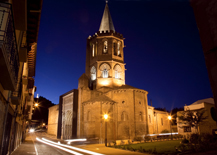
Locality: SANGÜESA (31400)
Address: Calle Mayor, 1
Zone: The Central Zone
Style: Romanesque
Centuries of construction: XII
Tel.: 948870132
The church of Santa María la Real in Sangüesa, declared a National Monument in 1889, has a magnificent façade (like an authentic stone altarpiece) that is considered one of the best examples of the Romanesque style in Spain.
Description
It depicts the Day of Judgement. Elegant in form and of medium size, it was built between the 12th and 15th centuries in transitional style in the period between Romanesque and Gothic. It has three naves with a crossing and octagonal tower, and the interior surprises the visitor with attractions such as the main altarpiece in Plateresque style, and rich Gothic processional items.
After crossing the iron bridge over the river Aragon, the church of Santa María la Real in Sangüesa welcomes you to this town in the eastern Central Zone of Navarre near the border with Aragon.
It was built in the 12th century at one end of the Rúa Mayor (main street) on orders of King Alfonso I ‘el Batallador’ (the warrior) of Navarre and Aragon. A medium-sized church, this beautiful example of Romanesque art has not just been used for worship throughout history but also for defence, especially during the civil wars of the 19th century.
Restored during the first half of the 20th century, it has a Romanesque header and three apses (the part that corresponds to the first half of the 12th century), while at the end of the 1200s and in the following centuries the naves were built, together with the south façade and the octagonal Gothic bell tower.
Although the building is of great beauty overall, its greatest artistic merit is found on the façade. A leisurely look at the two bodies of the church will reveal the hand of two maestros: Leodegarius, a French master from the end of the 12th century, who worked on the lower part, and a maestro from the Monastery of San Juan de la Peña (near Jaca), who undertook the upper part at the end of the 13th century.
Leodegarius, the more ?avant-garde’ of the two sculptors, made the six statue-columns that flank the façade, which is inspired by the front of Chartres Cathedral. On the left, Mary Magdalene, the Virgin Mary -with the mark of the author [“Leodegarius me fecit”] on the book she carried in her hands- and Mary mother of St James and St John. On the right, the apostles Peter, Paul and Judas hung. The capitals represent various passages from the Bible.
The master from San Juan de la Peña, from the ‘old school’, is thought to have made the double arches with the twelve apostles presided over by the Pantocrator. Its figures are hieratical with simple, incisive folds and square faces with large eyes.
In a prominent place in the centre of the tympanum is Christ judging men alongside the Virgin Mary, with the apostles as intercessors and St Michael weighing the souls. The archivolts that surround the tympanum depict different levels of mediaeval society. On both sides of the archivolts monstrous animals are sculpted together with scenes from the Old and New Testaments, images of sin and a variety of trades. On the lean right-hand side the reliefs that tell the Nordic legend of the hero Sigurd stand out: Sigurd was the son of King Sigmund who killed the dragon Fafner and, after bathing in its blood, was able to understand the language of the birds and became invincible.
Inside
A look inside the church reveals its structure: three naves and three sections, which hold treasures such as the main altarpiece (in Plateresque style from the 16th century), the chapel of St Michael (15th century), or the chapel of La Piedad (Pity) (16th century), which houses a set of the Descent (16th century) and canvases from the 18th century. The 15th-century processional silver custody is one of the oldest in Spain.
Also stop to admire a stained glass window dedicated to the Virgin Mary, a Baroque crucifix, the Gothic image of San Blas, the neo-Romanesque altarpiece of St Francis Xavier and the small recess with a Romanesque grille that is home to the image of the Blessed Virgin.
And very nearby…
Using Santa María as an excuse, discover the rest of monumental Sangüesa and do not miss other emblematic places nearby, such as the Castle of Javier or the Monastery of Leyre. If you want to experience a really special moment, listen to the Gregorian chants of the monastery’s Benedictine monks. To finish, why not take a walk through the Foz (gorge) of Lumbier on the path that follows the abandoned ‘Irati’ railway line, along which the first electric train in Spain ran.







